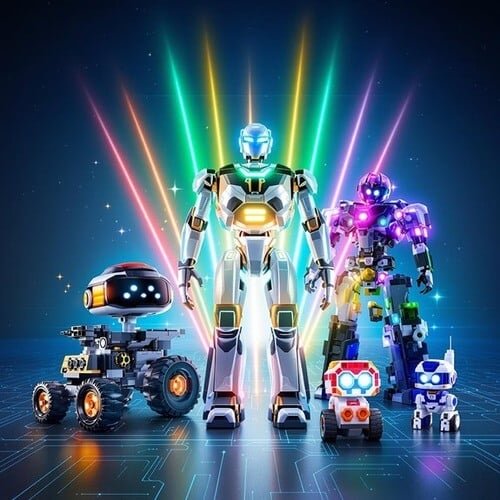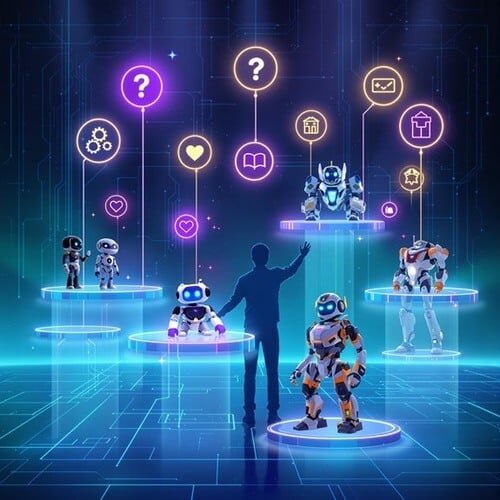Robot Toys Hub
Welcome to Robot Toys Hub, your go-to destination for everything robotic and playful!
From transforming bots to programmable companions, we review the coolest robot toys on the market. Our passionate team provides detailed reviews, buying guides, and insider tips to help parents find age-appropriate options while collectors uncover rare gems.
Whether you’re shopping for educational STEM robots or action-packed battlebots, we offer honest insights and coverage of the latest product launches. Our comprehensive guides cover everything from budget-friendly starter bots to premium collectibles, ensuring you make informed decisions.
Join our community of robot toy enthusiasts and find the perfect mechanical friend today!
Explore the Robot Toys Hub

What Are Robot Toys?
When you explore robot toys, you’re discovering playthings that combine sensors, computation, and motors to interact intelligently with their environment, distinguishing them from simple mechanical toys. Modern robot toys utilize colorful parts and intuitive interfaces to make technology approachable for children without the feeling of studying.
These devices differ from educational robots primarily in their emphasis on entertainment and affordability, though modern versions increasingly blur this distinction by incorporating programming interfaces and STEM learning features.
The popularity of robot toys stems from their ability to engage children ages 3-16 through interactive behaviors, voice recognition capabilities, and customizable programming options that develop both cognitive skills and technological literacy.

Definition of Robot Toys
Robot toys represent a unique category of playthings that combine sensors, computational processing, and motorized components to create interactive experiences with their environment.
You’ll find these devices incorporate various elements that distinguish them from traditional toys:
Sensors – Detect environmental inputs like sound, light, or touch
Computational units – Process information and execute programmed responses
Motors – Enable movement, gestures, and physical interactions
User interfaces – Allow children to control or program behaviors
Modern robot toys merge entertainment with educational affordances. Notable examples like Lego MindStorms and Furby, both introduced in 1998, demonstrate how these toys can range from complex programmable platforms to simple interactive companions. However, they’re specifically engineered for durability and age-appropriate interaction, typically serving children ages 5-16 through engaging play experiences.
Difference Between Robot Toys and Educational Robots
Although both robot toys and educational robots incorporate sensors and motors, you’ll discover fundamental differences in their design philosophy and intended outcomes.
Robotic toys prioritize entertainment through remote-controlled movements and preset actions, offering fun without structured learning objectives.
However, educational robots deliberately foster STEM skills through programming interfaces, block coding, and problem-solving challenges. Models like Thymio robot come with online courseware included in the purchase, providing structured pathways for learning robotics and coding concepts.
While your 5-8 year old might enjoy a dinosaur robot’s movements, educational models for ages 8-16 transform children into creators who program behaviors, debug code, and develop computational thinking.
Educational robots integrate companion apps, structured activities, and adaptive learning experiences that build transferable engineering skills.
Why Robot Toys Are Popular
Beyond the specific educational benefits that distinguish robot toys from their learning-focused counterparts, you’ll find these interactive devices have captured children’s imaginations for compelling reasons.
These factors explain their widespread appeal:
- Technological accessibility – Advanced robotics features now cost considerably less, making sophisticated robot toys for beginners affordable.
- Interactive engagement – Voice recognition and responsive behaviors create dynamic play experiences surpassing traditional toys. These toys teach kids fundamental concepts about sensors and mechanics through hands-on interaction.
- Entertainment versatility – Children aged 5-16 enjoy diverse activities from programming challenges to interactive games.
- Entertainment versatility – Children aged 5-16 enjoy diverse activities from programming challenges to interactive games.
- Social development – Robot companions foster both collaborative play and independent exploration, supporting various developmental stages.
Types of Robot Toys
When you’re exploring robot toys for children, you’ll encounter five main categories that offer distinct learning experiences and engagement opportunities.
Desktop robots like Cozmo and Vector provide compact, AI-powered companions that enhance cognitive development through programmable games and autonomous behaviors, making them ideal for ages 8–16. These consumer robots mirror the AI-powered companions trend seen in adult-oriented robots like LOVOT, bringing sophisticated interaction capabilities to children’s toys.
Additionally, these categories range from cuddly robot pets that respond to touch and voice commands, to remote-controlled robots for competitive play, and building kits that introduce engineering concepts through hands-on assembly.

Desktop Robots
Desktop robots represent a diverse category of tabletop companions that transform your child’s workspace into an interactive learning environment.
- Educational coding robots teach programming through block-based platforms, promoting STEM cognition for ages 5-16. Popular models like the Makeblock mBot start at $80 and include gamified app lessons with pre-programmed modes for immediate engagement.
- AI-enabled models feature facial recognition and 1000+ expressions, adapting to user behavior.
Family assistant robots manage schedules while supporting homeschooling activities. - Gaming robots combine arcade-style challenges with customizable programming apps.
- Desktop robots provide multifunctional affordances, from screen-free coding to voice-activated learning, ensuring sustained engagement across developmental stages.
Robot Pets
Why do children form emotional bonds with robotic companions that bark, purr, or roar?
Robot pets provide interactive companionship through advanced AI that enables personality development and emotional responses. Models like Sony’s AIBO ERS-1000 and WowWee CHiP recognize voices, respond to touch sensors, and display mood variations through movements and sounds. Through cloud memory integration, these robotic pets continuously update and evolve their behaviors over time, creating unique personalities based on owner interactions.
These robotic companions offer significant advantages for families, including allergy-free interaction and minimal maintenance requirements. However, they can’t fully replicate the warmth and spontaneous behaviors of biological pets.
For children ages 5-16, companion apps enhance engagement by allowing remote control, behavior customization, and scheduled playtimes.
Interactive Robots
Interactive robots transform traditional play into dynamic learning experiences through advanced features that respond to children’s actions and commands.
These interactive robot toys offer:
- Voice recognition enabling natural conversations and command responses
- Gesture control allowing hands-free interaction through movement detection
- Face detection personalizing experiences by recognizing individual users
- Programming capabilities supporting Python and C for advanced learners
Designed for ages 8-16, these robots bridge entertainment and education effectively.
For example, companion apps enhance functionality while developing computational thinking skills. Premium interactive models like the Silverlit O.P One robot showcase advanced features with a $174.99 price point reflecting sophisticated technology integration.
However, their sophisticated AI features require parental guidance to maximize learning affordances and guarantee appropriate engagement levels.
Remote-Controlled Robots
Three distinct categories of remote-controlled robots dominate today’s educational toy market, each offering unique cognitive development opportunities for children aged 5-16.
You’ll find programmable models like Dash and Lego Mindstorms that teach coding through companion apps, entertainment-focused robots including Anki Cozmo with personality-driven interactions, and pet-like alternatives such as Robo Pets Cat for companionship without maintenance.
These remote-controlled robots enhance spatial reasoning and problem-solving skills through wireless operation and sensor-based responsiveness, utilizing radio frequency technology that enables control from distances exceeding 100 feet.
For example, Sphero mini combines app-based programming with physical movement control, while transforming vehicle-robots offer multiple play modes that sustain engagement across developmental stages.
Building and DIY Robot Kits
Building and DIY robot kits transform construction time into extensive learning experiences through hands-on assembly, programming, and customization opportunities.
You’ll discover these kits develop computational thinking and mechanical skills through progressive challenges.
Consider these popular DIY robot kits:
- Lego Education Spike Prime (ages 10+): Features 500+ pieces with 40 guided lessons
- Makeblock Ultimate 2.0: Offers 10 different builds programmable via Scratch, Arduino, or Python
- Hexapod Walking Kits: Include 18-servo configurations for advanced builders
- Raspberry Pi-based Kits: Provide modular platforms supporting sensor expansion
These kits enhance cognition through problem-solving while offering meaningful parent-child collaboration opportunities. The Petoi DIY kits starting at $269 include programmable robot dogs and cats with free online coding curriculum for beginners through advanced users.
How to Choose a Robot Toy
When selecting a robot toy, you’ll need to evaluate multiple factors including your child’s developmental stage, the toy’s educational affordances, and your budget constraints.
The process involves matching the robot’s complexity to your child’s age group—for example, simple remote-controlled models for ages 4-6 versus programmable kits for ages 10-16—while considering features that enhance cognition through coding or problem-solving activities. It’s equally important to check for safety certifications to ensure the toy meets industry standards for materials and construction quality.
Additionally, you should assess the toy’s build quality, device compatibility requirements, and whether its interactive capabilities justify the investment, as prices range from basic $30 models to advanced $300 systems with smartphone integration.

Consider the Age and Skill Level
A robot toy’s effectiveness depends greatly on matching its complexity and features to your child’s developmental stage and current abilities.
Consider these age-appropriate guidelines when selecting the best robot toys for kids:
- Ages 3-5: Choose simple remote-control robots focusing on cause-effect understanding.
- Ages 5-8: Select beginner coding robots like Botley introducing foundational STEM concepts.
- Ages 8-12: Opt for building kits combining mechanical assembly with programming capabilities.
- Ages 10+: Consider sophisticated platforms offering customization and advanced coding challenges.
Matching skill levels prevents frustration while maintaining engagement, ensuring your child develops computational thinking through appropriately challenging interactive experiences. Research shows that children aged 3-6 years experience higher learning gains when introduced to age-appropriate robotics, establishing crucial foundational problem-solving skills.
Evaluate Features and Interactivity
After narrowing your options based on age appropriateness, you’ll need to examine the specific features and interaction modes that different robot toys offer.
Consider whether you want AI-powered responses, voice recognition, or sensor-based interactions that enhance engagement. Advanced toy robots provide learning algorithms that adapt to your child’s preferences over time, creating personalized experiences.
Entertainment models emphasize games and activities, while educational versions develop STEM skills through programming interfaces. Features like Bluetooth connectivity enable app control and updates, expanding play possibilities. Major manufacturers like LEGO and Sphero lead innovation in these interactive capabilities, offering unique functionalities that set their products apart in the competitive market.
Evaluate these affordances against your goals—whether fostering creativity, supporting cognition, or encouraging social-emotional development through interactive companionship.
Assess Durability and Quality
Since robot toys often endure active play and potential mishandling, you’ll want to prioritize durability assessments that predict long-term performance and value.
Consider these essential robot toy features:
- Impact resistance – Drop-tested designs withstand falls from typical play heights
- Water protection – IP ratings indicate resistance to spills and moisture exposure
- Material quality – Reinforced plastics and metal components resist stress-induced fractures
- Modular construction – Replaceable parts extend operational lifespan considerably
Quality certifications provide standardized benchmarks for environmental durability, ensuring your investment maintains functionality through years of interactive engagement and educational exploration. Advanced compression testing demonstrates that well-designed robots can maintain functionality even after supporting 145 pounds of weight, indicating exceptional structural integrity for demanding play scenarios.
Check Compatibility with Devices
Before you’ll commit to purchasing a robot toy, verify that your household’s smartphones, tablets, or computers meet the necessary technical requirements for ideal functionality.
Most robot toys require iOS 13+ or Android devices with Bluetooth 4.0 capabilities for companion apps, which enable programming and interactive play.
The robot toys hub emphasizes checking manufacturer compatibility lists, as older operating systems may lack support for essential features. For example, Sphero Mini works with Chrome, Mac, PC, iOS, Android, and Kindle devices, ensuring broad accessibility across different platforms.
Additionally, consider hardware specifications like processor speed and available storage, particularly for advanced playfulness robotics that demand substantial resources.
These technical affordances directly impact your child’s cognitive development opportunities through seamless device integration.
Set a Budget
When you’re ready to choose a robot toy, establishing a realistic budget serves as the foundation for making an informed purchasing decision that balances cost with educational value.
Interactive robots range from $10 entry-level models to premium $180+ options with advanced features. These toys are specifically designed to teach coding skills, making them valuable educational investments beyond simple entertainment.
Consider these budgeting factors:
- Age alignment – Simple robots for ages 5-7 cost $10-40, while programmable options for 8-16 require $50-150
- Feature priorities – Voice control increases prices by 40-60%
- Longevity value – Expandable robots offer better long-term engagement
- Hidden costs – Factor in batteries, accessories, and potential app subscriptions
Set a budget ceiling before shopping to prevent overspending.
Frequently Asked Questions
How Do I Troubleshoot Common Issues With My Robot Toy?
First, check if your toy’s batteries are fresh and properly installed. Clean the wheels and sensors with a soft cloth. If it’s still not working, try resetting it by turning it off and on.
What Batteries Do Different Robot Toys Require?
You’ll find most robot toys use AA or AAA alkaline batteries for basic models. Advanced robots like Cozmo or Vector require built-in lithium-ion rechargeable packs, while some educational robots need specific battery configurations for ideal performance.
Are Robot Toys Safe for Toddlers Under Age 3?
You’ll need to carefully check robot toys for small parts that pose choking hazards. Choose age-appropriate models without detachable components, toxic materials, or accessible batteries. Always supervise toddlers and verify safety certifications before purchasing.
Can Robot Toys Connect to Smart Home Devices?
You’ll find most robot toys don’t connect to smart home devices. While advanced AI robots offer Wi-Fi or app connectivity, typical educational and entertainment robots lack integration with Alexa, Google Home, or similar systems.
What Is the Typical Warranty Period for Robot Toys?
You’ll typically get a 12-month warranty covering main components like chargers, batteries, and motors. Some manufacturers offer extended plans up to three years, but coverage varies by model and whether you choose standard or extended protection.
Conclusion
You’ve discovered how robot toys combine entertainment with educational value through interactive features and cognitive development opportunities. By evaluating durability, compatibility, and budget considerations, you’ll select toys that engage children ages 5–16 effectively. Whether choosing AI-powered companions or programmable models, these innovative toys offer lasting value through companion apps and evolving capabilities. Your informed decision will provide children with enriching play experiences that foster creativity, problem-solving skills, and technological literacy for years ahead.


